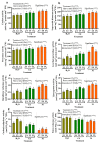Alleviation of Cadmium and Nickel Toxicity and Phyto-Stimulation of Tomato Plant L. by Endophytic Micrococcus luteus and Enterobacter cloacae
- PMID: 35956496
- PMCID: PMC9370581
- DOI: 10.3390/plants11152018
Alleviation of Cadmium and Nickel Toxicity and Phyto-Stimulation of Tomato Plant L. by Endophytic Micrococcus luteus and Enterobacter cloacae
Abstract
Cadmium (Cd) and nickel (Ni) are two of the most toxic metals, wreaking havoc on human health and agricultural output. Furthermore, high levels of Cd and Ni in the soil environment, particularly in the root zone, may slow plant development, resulting in lower plant biomass. On the other hand, endophytic bacteria offer great promise for reducing Cd and Ni. Moreover, they boost plants' resistance to heavy metal stress. Different bacterium strains were isolated from tomato roots. These isolates were identified as Micrococcus luteus and Enterobacter cloacae using 16SrDNA and were utilized to investigate their involvement in mitigating the detrimental effects of heavy metal stress. The two bacterial strains can solubilize phosphorus and create phytohormones as well as siderophores. Therefore, the objective of this study was to see how endophytic bacteria (Micrococcus luteus and Enterobactercloacae) affected the mitigation of stress from Cd and Ni in tomato plants grown in 50 μM Cd or Ni-contaminated soil. According to the findings, Cd and Ni considerably lowered growth, biomass, chlorophyll (Chl) content, and photosynthetic properties. Furthermore, the content of proline, phenol, malondialdehyde (MDA), H2O2, OH, O2, the antioxidant defense system, and heavy metal (HM) contents were significantly raised under HM-stress conditions. However, endophytic bacteria greatly improved the resistance of tomato plants to HM stress by boosting enzymatic antioxidant defenses (i.e., catalase, peroxidase, superoxide dismutase, glutathione reductase, ascorbate peroxidase, lipoxygenase activity, and nitrate reductase), antioxidant, non-enzymatic defenses, and osmolyte substances such as proline, mineral content, and specific regulatory defense genes. Moreover, the plants treated had a higher value for bioconcentration factor (BCF) and translocation factor (TF) due to more extensive loss of Cd and Ni content from the soil. To summarize, the promotion of endophytic bacterium-induced HM resistance in tomato plants is essentially dependent on the influence of endophytic bacteria on antioxidant capacity and osmoregulation.
Keywords: antioxidant defenses; bioconcentration factor; heavy metals; specific regulatory defense genes; translocation factor.
Conflict of interest statement
The authors declare no conflict of interest.
Figures











References
-
- Ore O.T., Adeola A.O. Toxic metals in oil sands: Review of human health implications, environmental impact, and potential remediation using membrane-based approach. Energy Ecol. Environ. 2021;6:81–91. doi: 10.1007/s40974-020-00196-w. - DOI
-
- Thakare M., Sarma H., Datar S., Roy A., Pawar P., Gupta K., Pandit S., Prasad R. Understanding the holistic approach to plant-microbe remediation technologies for removing heavy metals and radionuclides from soil. Curr. Res. Biotechnol. 2021;3:84–98. doi: 10.1016/j.crbiot.2021.02.004. - DOI
-
- Xu D.-M., Fu R.-B., Liu H.-Q., Guo X.-P. Current knowledge from heavy metal pollution in chinese smelter contaminated soils, health risk implications and associated remediation progress in recent decades: A critical review. J Clean. Prod. 2020;286:124989. doi: 10.1016/j.jclepro.2020.124989. - DOI
-
- Hossain M.J., Bakhsh A. Environment, Climate, Plant and Vegetation Growth. Springer; Berlin, Germany: 2020. Development and applications of transplastomic plants; a way towards eco-friendly agriculture; pp. 285–322. - DOI
LinkOut - more resources
Full Text Sources
Miscellaneous

